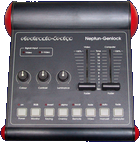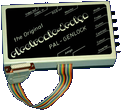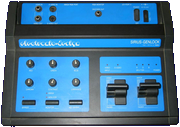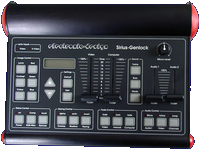Manufacturer “Electronic Design”
18 expansions in database
Manufacturer Electronic Design, Germany | Date 1992 | Amiga A500 | Interface side expansion port | Autoconfig ID 10676 / 136 |
- sixteen ZIP sockets for up to 8 MB RAM
- accepts 256k×4 and 1M×4 ZIPs in groups of four giving configurations from 512 kB to 8 MB
- DIP switch for RAM configuration (accessible from outside)
- power LED
Manufacturer Electronic Design / ProDAD, Germany | Amiga any Amiga | Interface serial port, parallel port |
- video edit controller
- CAVIN - Computer, Audio and Video Integration
- supports recorders with 5 pin Edit (Panasonic), LANC (Sony), Control-L, RS-232 and RS-422 interfaces
- other recorders are controlled through their infra-red ports - in this case single frame accuracy is impossible
- RCTC, VITC and RAPID timecode support
- works together with ClariSSA, Monument Titler and Adorage
- ARexx port
Manufacturer Electronic Design, Germany | Date 1992 | Amiga A2000, A3000, A4000 | Interface video slot |
- flicker fixer
- works only in 12 bit (4096 colours), no AGA compatibility, partial ECS compatibility
- SuperHiRes and SuperHiRes Interlaced work fine, Productivity does not
- has problems with NTSC screen modes
- HD15 VGA connector
- the manufacturer has given general guarantee that its Flicker-Fixer works with all genlocks - well, many genlocks are supported, but not all
- stereo audio amplifier (2× 1 Watt sinus) for volume control
- two RCA audio output connectors
- ED-FlickerFixer.pdf
Operating Instructions (german/english)
132 kB
- ED-FlickerFixer.dms
install disk
172 kB
Manufacturer Electronic Design, Germany | Date 1992 | Amiga A3000, A4000 | Interface Zorro II, video slot | Autoconfig ID 10676 / 1 |
- realtime digitizer/framegrabber
- SVHS (Y/C) and FBAS (CVBS) inputs
- standard 23 pin male connector (compatible with the usual Amiga video connector) which is without the Prism24 add-on useless
- I2C-Bus connector
- supports both PAL and NTSC video standards
- supported resolutions: 720×570, 360×285, 240×192, 180×144, 120×96
- overscan is controllable by software
- 1 MB 30 ns Video Field RAM
- digitizer uses 4:1:1 video sampling, Prism24 uses 4:2:2
- digitized video can be read from the onboard video RAM as raw-data in double buffering mode
- the Xilinx chip performs realtime scaling of the video data and provides an interface for the Prism24 board
- revision 2 boards support AGA, the older ones not
- optional Denise adaptor for Amiga 2000
- VHI driver
-
optional Prism 24 (
- the Prism 24 activates the 23 pin video connector
- it can pass-through the digitized video or perform red, green, blue, colour, brightness and contrast adjustments to the output
- adds genlock capability to the FrameMachine, taking the Amiga's video signal from the video slot
- the genlock features are:
- FrameMachine mode
- Amiga mode
- Amiga over FrameMachine Key mode
- FrameMachine over Amiga mode
- "B0-Keying" mode (color B0 is transparent)
- with FrameMachine's realtime video features, it can do PIP (picture in picture) of real video and computer video on one screen
- combined with a standard external Amiga Genlock, there is also the possibility to do PIP of two real video sources together with an Amiga overlay
- AGA compatible Prism 24s have jumpers which allow the selection of the machine type
- FrameMachine.pdf
Bedienungsanleitung
5.3 MB - FrameMachine_AGA-Ergaenzung.pdf
AGA-Ergänzung zur Bedienungsanleitung
1376 kB - FrameMachine_Y-Cable.pdf
manual for Y-Cable
16 kB - FrameMachine_Y-Kabel.pdf
Anleitung für Y-Kabel
16 kB
- FastEasyEffects-1.dms
Fast Easy Effects disk 1
781 kB - FastEasyEffects-2.dms
Fast Easy Effects disk 2
832 kB - FrameMachine-10-1.dms
install disk 1, v1.0
349 kB - FrameMachine-10-2.dms
install disk 2, v1.0
554 kB - FrameMachine_20-1.dms
install disk 1, v2.0
373 kB - FrameMachine_20-2.dms
install disk 2, v2.0
561 kB - FrameMachine_21-1.dms
install disk 1, v2.1
295 kB - FrameMachine_21-2.dms
install disk 2, v2.1
545 kB - FrameMachine_23-1.dms
install disk 1, v2.3
291 kB - FrameMachine_23-2.dms
install disk 2, v2.3
214 kB - FrameMachine_25-1.dms
install disk 1, v2.5
263 kB - FrameMachine_25-2.dms
install disk 2, v2.5
214 kB - FMdriver.lha
Aminet
driver, TV on Workbench
356 kB - FMdriverVHI.lha
Aminet
VHI driver
15 kB
Manufacturer Electronic Design, Germany | Date 1992 | Amiga any Amiga | Interface parallel port |
- realtime framegrabber
- 24 bit realtime framegrabbing
- 320×256 - 704×570 (PAL), 320×200 - 704×458 (NTSC)
- composite and Y/C inputs - multiple video sources can be connected and selected by software
- 3 MB, 40 ns DRAM on board
- grabs images quickly into its own memory but transferring and displaying through the parallel port is slow
- digitised images are stored in YUVN format and can be saved in IFF24, RGB8, YUVN and EDAN formats
- FrameStore software v2.0 (1993) adds support for the AGA screen modes
- ADPro loader
- ARexx port
- external power supply
- FrameStore-121.dms
install disk v1.21
450 kB - FrameStore-201.dms
install disk v2.01 including AdPro loader
274 kB
Manufacturer Electronic Design, Germany | Date 1994 | Amiga any Amiga | Interface RGB port, serial port |
- genlock
- composite and Y/C inputs and outputs
- automatic input recognition with priority for the Y/C signal
- color, contrast and luminance knobs for the source video signal
- independent fading of the computer and video image
- fade to black
- manual fading - the faders serve to set the degree of blending
- automatic fading - the faders serve to set the fading time between 0.2 - 20 seconds
- RGB monitor switch: switches the display between genlock and computer picture without affecting the video outputs
- keying active switch: allows imposing the computer picture over a static video picture - when inactive the fader can be used to dissolve between full computer and video picture
- keying invert switch: when inactive, video is projected onto the computer image where color 0 is - when active, video is shown at positions other than color 0
- alpha overlay switch: allows semi-transparent colors or anti-aliasing
- built in black burst generator for recording the computer image without receiving a video source
- VITC timecode support
- all functions can be controlled by software through the serial port
- integrated ARexx port
- standby mode - when the genlock is not needed it is possible to work on the computer without disconnecting it - all Amiga screen modes are passed through to the RGB monitor
- for operation with the A3000's video enhancer, the "A3000" jumper has to be set on the Neptun's circuit board
- takes power from the RGB port, but can use an external power supply too
- Neptun.pdf
Operating Manual / Bedienungsanleitung (en/de)
16.7 MB
- Neptun.dms
install disk (genlock.library v2.2, Neptun Hotkey v2.2)
300 kB
Manufacturer Electronic Design, Germany | Date 1991 | Amiga any Amiga | Interface RGB port |
- genlock
- composite input and output
- color, contrast and luminance knobs for the source video signal
- fading and superimposing
- inverter switch: when off, video is projected onto the computer image where color 0 is - when set, video is shown at positions other than color 0
- built in blackburst generator - when no video source is connected, the genlock still can be used to record the computer image
- built in manual RGB splitter for monochrome digitisers
Manufacturer Electronic Design, Germany | Date 1996 | Amiga any Amiga | Interface RGB port |
- genlock
- composite and Y/C inputs and outputs
- automatic input recognition with priority for the Y/C signal
- color, contrast and luminance knobs for the source video signal
- RGB monitor switch: switches the display between genlock and computer picture - does not affect the video outputs
- keying active switch: allows imposing the computer picture over a static video picture - when inactive the fader can be used to dissolve between full computer and video picture
- keying invert switch: when inactive, video is projected onto the computer image where color 0 is - when active, video is shown at positions other than color 0
- internal blackburst generator - when no video source is connected, the genlock still can be used to record the computer image
- standby mode - when the genlock is not needed it is possible to work on the computer without disconnecting it - all Amiga screen modes are passed through to the RGB monitor
- for operation with the A3000's video enhancer, the "A3000" jumper has to be set on the Pluto's circuit board
- takes power from the RGB port, but can use an external power supply too
Manufacturer Electronic Design, Germany | Date 1992 | Amiga A2000, A3000, A4000 |
- video processor
- Prism 24 is the optional video processor module of FrameMachine
- can perform red, green, blue, colour, brightness and contrast adjustments to the video output
- adds genlock capability to the FrameMachine, taking the Amiga's video signal from the video slot
- PIP (picture in picture) of real video and computer video on one screen
- combined with a standard external Amiga Genlock, it is possible to do PIP of two real video sources with an Amiga overlay
- AGA compatible Prism 24s have jumpers which allow the selection of the machine type
Manufacturer Electronic Design, Germany | Date 1991 | Amiga any Amiga | Interface RGB port, joystick port |
- Sirius is a name variation of the Hama Genlock 290
- the only difference is the blue casing
Manufacturer Electronic Design, Germany | Date 1995 | Amiga any Amiga | Interface RGB port, serial port |
- genlock
- composite and Y/C inputs and outputs
- automatic input recognition with priority for the Y/C signal
- adjustable color, contrast, luminance and white level (separate red, green, blue) of the source video signal
- adjustable black level of the computer image
- picture parameters can be stored and recalled
- independent fading of the computer and video image
- fade to black
- manual fading - the faders serve to set the degree of blending
- automatic fading - the faders serve to set the fading time between 0.2 - 20 seconds
- RGB monitor switch: switches the display between genlock and computer picture without affecting the video outputs
- bluebox keying switch: turns on Chroma and Luma keying - finds a specific color with a certain tolerance (to compensate for noise) in the video picture for keying
- keying invert switch: when inactive, video is projected onto the computer image where color 0 is - when active, video is shown at positions other than color 0
- alpha overlay switch: allows semi-transparent colors or anti-aliasing
- built in black burst generator for recording the computer image without receiving a video source
- built in test image generator for optimized adjustment of all image parameters
- sound mixer
- two stereo inputs (4× RCA)
- microphone input (1× 3.5 mm jack)
- stereo output (2× RCA)
- microphone volume adjustment knob
- faders control the volume of the two audio channels
- during automatic fading the video and audio faders can be synchronized
- adjustable treble, bass and gain for all three audio sources independently
- notes
- LCD display for picture and audio parameters and values
- VITC timecode support
- all functions can be controlled through the serial port
- integrated ARexx port
- standby mode - when the genlock is not needed it is possible to work on the computer without disconnecting it - all Amiga screen modes are passed through to the RGB monitor
- for operation with the A3000's video enhancer, the "A3000" jumper has to be set on the Sirius' circuit board
Manufacturer Electronic Design, Germany | Date 1996 | Amiga any Amiga | Interface serial port |
- video edit controller
- the hardware part is basically a custom serial interface cable connecting the Amiga with the video recorder's edit terminal
- supports recorders with either 5 pin Edit (Panasonic) or LANC (Sony) interface
- other recorders are controlled through their infra-red ports - in this case single frame accuracy is impossible
- RCTC and LTC timecode support
- ARexx port
- SuperCut305.dms
install disk v3.0.5
383 kB
Manufacturer Electronic Design, Germany | Amiga any Amiga |
- time base corrector
- regenerates the video signal with precise synchronization to reduce the quality loss when copying or editing video
- composite and Y/C inputs
- composite, Y/C and YUV outputs
- automatic input recognition with priority for the Y/C signal
- blackburst output and built in blackburst generator - the TBC-Enhancer can be used as the pulse rate basis for the whole studio
- blackburst input - synchronizes the video source to the studio reference clock
- the phase relation of the colour subcarrier can be adjusted in addition to the H-Phase
- colour, contrast and RGB luminance adjustment
- colour-shift adjustment
- still picture, noise filter, copy protection decoder functions
- VITC timecode support
- LCD display for picture parameters and values
- four different picture settings can be stored and recalled
Manufacturer Electronic Design, Germany | Date 1996 | Amiga any Amiga | Interface serial port |
- time base corrector
- regenerates the video signal with precise synchronization to reduce the quality loss when copying or editing video
- single composite and Y/C inputs, two composite and two Y/C outputs
- automatic input recognition with priority for the Y/C signal
- colour hue, saturation, contrast and luminance adjustment knobs
- colour-shift adjustment
- smooth and sharpen filters
- bypass switch for comparing the original video with the enhanced signal
- full-frame memory to freeze live video at any time
- removes copy protection signals
- all functions can be controlled by software through the serial port
- TBCLight.dms
install disk
40 kB
Manufacturer Electronic Design, Germany | Date 1991 | Amiga A2000, A3000, A4000 | Interface video slot |
- video output
- FBAS (RCA) and Y/C outputs for recording the Amiga video signal
- standard Amiga RGB (DB23) output
- subcarrier phase adjustment
Manufacturer Vesalia Computer / Electronic Design, Germany | Amiga A2000, A3000, A4000 | Interface Zorro II | Autoconfig ID 10676 / 136 |
- FastRAM Expansion
- sixteen ZIP sockets for up to 8 MB RAM
- accepts 1M×4 ZIPs in groups of four giving 2, 4, 6 or 8 MB configurations
- disable switch
- half length card, plugs into Zorro-II-Slot
- OEM design by Electronic Design for Vesalia Computer
- DIP switch settings
| 1 ON OFF ON OFF | 2 ON ON OFF OFF | - 2 MB - 4 MB - 4 + 2 MB - 8 MB |
| 3 | ON - card disabled, ON - card disabled |
| 4 | no function if present |
- WinnerRAM2000.pdf
Anleitung / User manual (german)
613 kB
Manufacturer Electronic Design, Germany | Date 1991 | Amiga any Amiga |
- colour splitter
- allows grabbing of colour images with monochrome digitisers
- manual or automatic operation
- splits colours automatically for Deluxe View and DigiView
- composite and Y/C inputs
- can be used as a Y/C to RGB converter
- adjustable colour, contrast and luminance levels of the video input
Manufacturer Electronic Design / Hama, Germany | Date 1991 | Amiga any Amiga | Interface RGB port |
- genlock
- composite and Y/C inputs and outputs
- automatic input recognition with priority for the Y/C signal
- color, contrast and luminance knobs for the source video signal
- fading and superimposing
- inverter switch: when off, video is projected onto the computer image where color 0 is - when set, video is shown at positions other than color 0
- built in blackburst generator - when no video source is connected, the genlock still can be used to record the computer image
- built in manual RGB splitter for monochrome digitisers
 Amiga Hardware Database
Amiga Hardware Database




















































